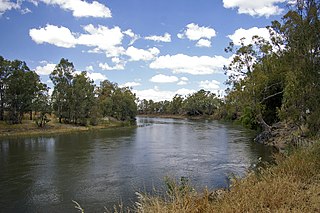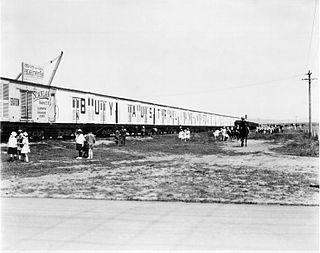
Murrumbidgee River, a major tributary of the Murray River within the Murray–Darling basin and the second longest river in Australia. It flows through the Australian state of New South Wales and the Australian Capital Territory. It descends 1,500 metres (4,900 ft) as it flows 1,485 kilometres (923 mi) in a west-northwesterly direction from the foot of Peppercorn Hill in the Fiery Range of the Snowy Mountains towards its confluence with the Murray River near Boundary Bend.

The Riverina is an agricultural region of south-western New South Wales, Australia. The Riverina is distinguished from other Australian regions by the combination of flat plains, warm to hot climate and an ample supply of water for irrigation. This combination has allowed the Riverina to develop into one of the most productive and agriculturally diverse areas of Australia. Bordered on the south by the state of Victoria and on the east by the Great Dividing Range, the Riverina covers those areas of New South Wales in the Murray and Murrumbidgee drainage zones to their confluence in the west.

Group 9 is a rugby league competition based in Wagga Wagga, New South Wales, Australia, and surrounding areas. The competition is played in five grades, with these being Under 17s, Under 19s, Women's League-Tag, Reserve-Grade and First-Grade.

Cootamundra is a town in the South West Slopes region of New South Wales, Australia and within the Riverina. It is within the Cootamundra-Gundagai Regional Council. At the 2016 Census, Cootamundra had a population of 6,782. It is located on the Olympic Highway at the point where it crosses the Muttama Creek, between Junee and Cowra. Cootamundra is not on the Hume Highway, but its railway station is on the Main Southern line, part of the Melbourne-to-Sydney line. Abb McAlister was elected mayor of the newly-formed Cootamundra-Gundagai Regional Council on 21 September 2017.

Burrinjuck was an electoral district of the Legislative Assembly in the Australian state of New South Wales from 1950 to 2015.
The South West Slopes is a region predominantly in New South Wales, Australia. It covers the lower inland slopes of the Great Dividing Range extending from north of Cowra through southern NSW into western Victoria. More than 90% of the region is in the state of New South Wales and it occupies about 10% of that state.

The ACT and Southern NSW Rugby Union is the governing body for rugby union in the Australian Capital Territory and southern regions of New South Wales.

The Main Southern Railway is a major railway in New South Wales, Australia. It runs from Sydney to Albury, near the Victorian border. The line passes through the Southern Highlands, Southern Tablelands, South West Slopes and Riverina regions.

The Roman Catholic Archdiocese of Canberra and Goulburn is a Latin Rite archdiocese located in the Australian Capital Territory, and the South West Slopes, Southern Tablelands, Monaro and the South Coast regions of New South Wales, Australia. Erected in 1948, the archdiocese is directly subject to the Holy See.

Cootamundra is an electoral district of the Legislative Assembly in the Australian state of New South Wales.
The Farrer Football Netball League (FFNL) is an Australian rules football and netball competition containing nine clubs based in the Riverina region of New South Wales, Australia. The league features three grades in the Australian rules football competition, with these being First-Grade, Reserve-Grade and Under 17s. In the netball competition there are four grades, with these being A-Grade, A-Reserve Grade, B-Grade and C-Grade.

The Great White Train was an effort in the 1920s by Sydney-based industrialists to convince Australians to 'Buy Australian Made'.
Country Cricket New South Wales, is responsible for the development of cricket in regional New South Wales. It is under control of the governing body Cricket NSW.

NSW TrainLink is an Australian coach and train operator providing services throughout New South Wales and into the Australian Capital Territory. It also operates some interstate services to Victoria, Queensland and South Australia. It is the operating name of NSW Trains, an agency of Transport for NSW.
Australian Community Media & Printing (ACM) is a trading name of Rural Press Limited, a media company in Australia responsible for over 160 regional publications. Its mastheads include The Canberra Times, The Newcastle Herald, The Examiner, The Border Mail, The Courier and the Illawarra Mercury along with more than one hundred community-based websites across Australia and numerous agricultural publications including The Land and Queensland Country Life.
The 1904 New South Wales state election involved 90 electoral districts returning one member each. The election was conducted on the basis of a simple majority or first-past-the-post voting system. There were two significant changes from the 1901 election, the first was that women were given the right to vote, which saw an increase in the number of enrolled voters from 345,500 in 1901, to 689,490 in 1904. The second was that as a result of the 1903 New South Wales referendum, the number of members of the Legislative Assembly was reduced from 125 to 90. The combined effect of the changes meant that the average number of enrolled voters per electorate went from 2,764, to 7,661, an increase of 277%. Leichhardt was the only district that was not substantially changed, while The Macquarie and The Murray districts retained nothing but the name.













